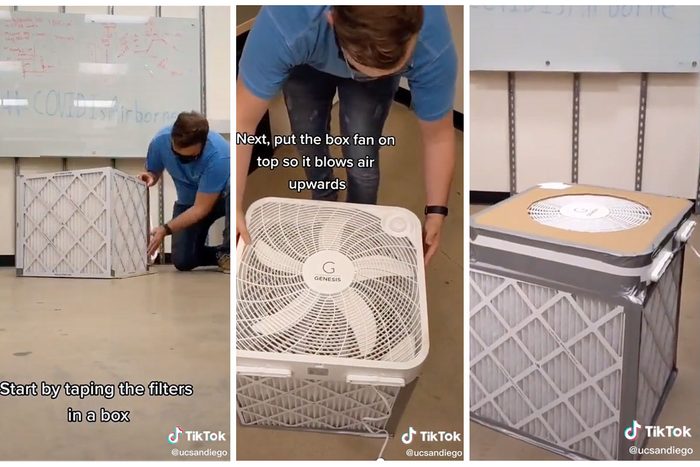Here’s How to Make This Super Handy DIY Air Cleaner

The Corsi-Rosenthal Box can reduce the amount of virus-laden aerosol particles in your home as well as any fancy filter at a quarter of the cost.
Our editors and experts handpick every product we feature. We may earn a commission from your purchases.
As we’ve heard consistently over the past three years, air purifiers can help protect against the spread of COVID-19. And as we enter into the fourth year of the pandemic, with new variants on the rise, many households are more concerned than ever about the cleanliness of their air.
Unfortunately, CDC-approved portable high-efficacy particulate air (HEPA) cleaners can be expensive at $300 to $600 each. While you can certainly buy cheaper options, they may not be as effective.
The Corsi-Rosenthal Box
With these limitations in mind, Richard Corsi, dean of Engineering at UC Davis, and Jim Rosenthal, chief executive of Tex-Air filters, teamed up to create an affordable DIY option in August 2020. The resulting Corsi-Rosenthal Box is easy to assemble, cost-effective and uses items you likely already have around your home.
In terms of efficacy, scientists at the National Institute for Safety and Health performed a study proving that the Corsi-Rosenthal Box “reduced aerosol exposure up to 73%, depending on the design, filter thickness, and fan airflow.” A second trial from Brown University and the Massachusetts-based nonprofit the Silent Spring Institute showed that the boxes reduced the synthetic chemical PFAS by 40 to 60% and phthalates by 30 to 60% in the rooms in which they were installed.
How This DIY Air Cleaner Works
The fan in the bow pulls contaminated air through the filters, where contaminated particles are trapped. Clean air then flows into the middle of the box, and is pushed out again by the fan. The box thus helps reduce the spread of pathogens, as well as dust, pollen, wildfire debris and cleaning chemicals.
If you place the box in a 10 x 10 x 10-foot room, with the fan on low, you can expect it to filter about one-third of the room’s air every minute. This is referred to as its “clean air delivery rate,” 300 to 400 cubic feet per minute for the Corsi-Rosenthal Box.
Make Your Own DIY Air Cleaner
@ucsandiego UC San Diego grad student Adam Cooper shows us how to make a DIY air purifier to help stop the spread of Covid-19 #ucsd #ucsandiego #sciencetok #covid19
If you’d like to try the Corsi-Rosenthal Box for yourself, here’s everything you need to know to build one yourself.
Materials
To make the air cleaner, you will need:
- 4 (20 x 20 x 2-inch) household air filters
- 1 (20-inch) box fan
- Cardboard (such as the box the fan came in)
- Scissors
- Duct tape
The most important part of sourcing your materials is ensuring the quality of your air filters. Look for filters that have a MERV-13 rating, which confirms the filter’s ability to trap particles of a specific size.
According to Washington Post reporter Lena Sun, who recently tried building the box, these materials should set you back about $130. This does not take into account any materials you may already have on hand.
Directions
Corsi himself walks through the process here.
- Gather your materials.
- Position the shell. Position the filters so that the pleats are vertical, are the airflow arrows on the filters all point inside the box. For maximum durability and a perfectly square cube, abut the filters so that one skinny edge connects with the longer side of the other filter, continuing this pattern all around.
- Secure the shell with duct tape. Seal the full length of every connecting edge with duct tape so there are no gaps. Doubling up the tape is even better.
- Build the floor of the box. Cut your cardboard to fit the bottom of the box, then attach it to the filters with duct tape, sealing every edge completely.
- Position the box fan on the sixth side of the cube so that it will blow air out of the box into the surrounding room. Attach the box fan to the filters, ensuring that all gaps are completely taped up. If needed, you can use small pieces of cardboard in the corners to make sure no air escapes.
- Lastly, because a box fan’s blades do not reach fully to the corners of the fan, you need to cover those corners up with cardboard. The simplest way is to cut out triangles and tape them to the top of the fan, but if you’re feeling ambitious, you can cut a circle in the blades’ diameter out of a square and attach that.
- And that’s it! Plug the fan into an electrical outlet and turn it on!
Other Projects
Now that you’ve upped your COVID safety in the house, why not make another batch of masks? You don’t even need a sewing machine. Or, if this project inspired you to clean the air in your garage, try building a dust filter fan using any leftover filters. Stay safe and healthy out there!


